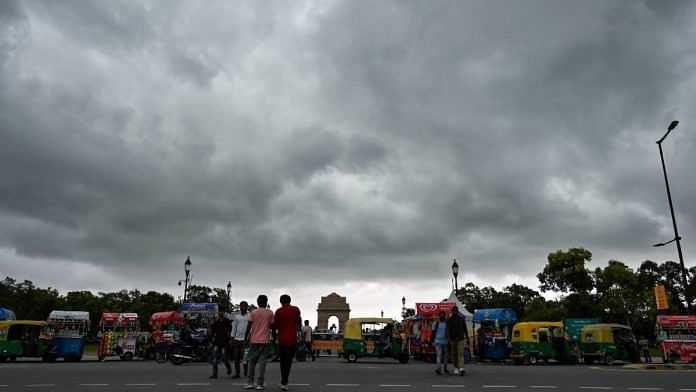New Delhi: Delhi Environment Minister Manjinder Singh Sirsa on Thursday announced that the city conducted its first-ever “successful” cloud seeding trials. A flight from IIT Kanpur took off on Thursday afternoon toward Delhi’s Burari, and injected a cloud with seeding chemicals to induce rain. However, this was only a physical ‘dry-run’ to test all mechanisms, and it did not lead to actual rainfall because there were minimal clouds.
“The Delhi government is now ready for cloud seeding in every way. We’ve gotten all the permissions, and we have done all trials too,” said Sirsa, in a video posted on X. “This is the first time in history we have conducted cloud seeding trials in Delhi.”
After the BJP-led Delhi government approved a Rs 3.21-crore outlay for cloud seeding trials in the Capital in May, this was the first time they were able to conduct the trial. Now, Sirsa said the government is ready to implement cloud seeding from October 28 to 30, provided the weather conditions are suitable. This will be the first time cloud seeding will be used in the city as a measure against air pollution, a chronic winter problem.
ThePrint explains what cloud seeding is, its scientific basis, and how it helps with pollution control.
What is cloud seeding?
The process of ‘seeding’ rain-bearing clouds with chemicals to create artificial rain is called cloud seeding, and it has been used around the world to create rain for multiple purposes. Even in India, certain states have conducted cloud seeding experiments since the 1970s, but none of them were for air pollution.
In Tamil Nadu in 1973 and in Mumbai in 1974, the Indian Institute of Tropical Meteorology (IITM) tried cloud seeding to induce rainfall during prolonged droughts. The method of cloud seeding requires certain simple chemicals like salt or silver iodide, which are non-hazardous, to speed up the process of producing rainfall.
In Karnataka, the state government even introduced a programme called Varshadhare in 2017 that included cloud seeding experiments, but that too was aimed at increasing rainfall in certain regions.
For Delhi’s cloud seeding experiments, the Aam Aadmi Party-led government in 2023 first considered using cloud seeding to combat pollution. The logic was that rainfall would help dissipate the suspended particular matter in the air, therefore leading to lower air quality index.
However, the decision did not move forward until 2025, when the BJP-led government signed a Memorandum of Understanding with IIT Kanpur to conduct the trials. The institute had previously conducted cloud seeding trials for Bundelkhand region in 2017, to increase rainfall.
On Thursday, a Cessna aircraft took off from IIT Kanpur for Delhi’s Burari carrying a mixture of chemicals for the seeding. Using the aircraft’s gas exhaust mechanism, the chemicals were injected into the clouds from the bottom with the help of flares. The aircraft then went back to IIT Kanpur.
“This flight was the proving flight for checking the capabilities for cloud seeding, the readiness and endurance of the aircraft, and the coordination among all agencies,” said IIT Kanpur in a press release. “There is no evidence of any precipitation as the clouds were very minimal and the moisture content was well below 15%,” it added.
Feasibility of cloud seeding
While cloud seeding is conceptually and scientifically sound, its uses are mainly for causing precipitation and rain, and its impact on reducing pollution has been less studied. A 2014 paper from Beijing said that a 1 mm increase in precipitation intensity led to a 4-28 per cent reduction in PM2.5 levels. However a more recent study from 2020 said this reduction depends on the kind of rainfall, the amount of pollution, and other factors like wind speed.
Also, there are broader concerns about using cloud seeding in Delhi during high pollution months, because of the lack of cloud cover.
“For cloud seeding we need two things — clouds and seeding. We have the seeding material prepared, the second we see clouds we will deploy them,” said Sirsa at a press conference in the city earlier in the week.
The BJP-led government in Delhi, while announcing the success of the cloud seeding trials, also said that the AAP government was unable to conduct the trials in their entire tenure.
However, back in 2024, when then-Delhi environment minister Gopal Rai wrote to the Ministry of Environment, Forest and Climate Change (MoEFCC) regarding cloud seeding trials for pollution, even the ministry had questioned the feasibility of the experiment.
Experts from the India Meteorological Department, Commission for Air Quality Management (CAQM), and the Central Pollution Control Board all said that the cloud cover in Delhi during December — when pollution is at its highest — is too low for cloud seeding.
“High altitude clouds, which are typically at elevations above 5-6 km, cannot be seeded due to aircraft limitations. Furthermore, effective cloud seeding requires specific cloud conditions, which are generally absent during Delhi’s cold and dry winter months,” read the expert opinion provided to the MoEFCC.
However, CM Rekha Gupta, in a post on X, hailed the cloud seeding trials as a win for science.
“This starts a new, scientific chapter in dealing with air pollution in the city. We hope that this will help us clean Delhi’s air and stabilise its environment,” she said.
(Edited by Aamaan Alam Khan)






